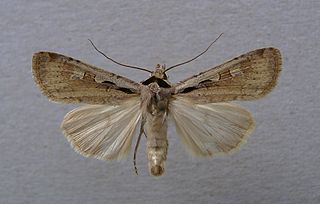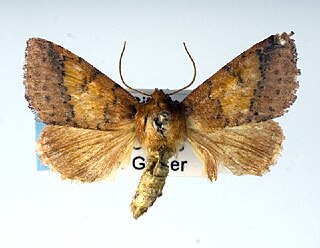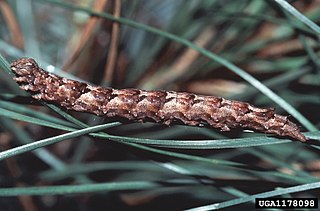Loxagrotis was a genus of moths of the family Noctuidae, it is now considered a subgenus of Dichagyris.

Acronicta fragilis, the fragile dagger moth, is a moth of the family Noctuidae. The species was first described by Achille Guenée in 1852. It is found in North America from Newfoundland to Florida, west across Canada, south to Kentucky and Minnesota. It is listed as a species of special concern in the US state of Connecticut.

Dichagyris musiva is a moth of the family Noctuidae. It is found in some mountainous areas of Europe, Turkey, Armenia, the Caucasus, Anatolia, southern Siberia, Mongolia, Tibet and western China.

Dichagyris flammatra, the black collar, is a moth of the family Noctuidae. The species was first described by Michael Denis and Ignaz Schiffermüller in 1775. It is found in central and southern Europe, Morocco, Algeria, Egypt, western Siberia, Armenia, the Caucasus, Turkey, Lebanon, Syria, Iraq, Iran, Tibet, Afghanistan and northern India.

S

Dichagyris flavina is a moth of the family Noctuidae. It is found in most of the Balkans and through large parts of the Near East and Middle East. It has been recorded from Bulgaria, Romania, North Macedonia, Greece, Turkey, southern Russia, Armenia, Syria, Lebanon, Israel, Jordan, Iran and Iraq.

Acronicta falcula, the corylus dagger moth, is a moth of the family Noctuidae. The species was first described by Augustus Radcliffe Grote in 1877. It is found in the United States and Canada from southern New England to southern Manitoba and Iowa. Recently seen from Wisconsin, Connecticut, Rhode Island, New York and Michigan. It is reported as rare in Ohio. It is listed as a species of special concern in the US state of Connecticut.
The fawn brown dart is a moth of the family Noctuidae. It is found in southern Canada and the northern United States from southern Quebec and eastern Massachusetts west to British Columbia and southern Washington. In the Rocky Mountain region it occurs as far south as northern New Mexico, north-eastern Arizona and central Idaho. It is listed as a species of special concern in Connecticut.

Euxoa adumbrata, the sordid dart, is a moth of the family Noctuidae. The species was first described by Eduard Friedrich Eversmann in 1842. In North America it is found across northern Canada from Quebec to western Alaska, south to the northern parts of the United States, and in the mountains to Colorado. It is also found in Greenland, the coastal areas of Scandinavia and the Ural. It was recently recorded from Denmark, although this includes Euxoa lidia, which some authors regard to be a valid species.

The orange sallow moth or Aureolariaseed borer is a species of moth of the family Noctuidae. It has a scattered distribution from southern Maine and the hills around Boston, Massachusetts, west across southern Ontario to south-western Wisconsin and Missouri, south into Florida and Texas. It is listed as threatened in the US state of Connecticut.

The pink star moth is a species of moth of the family Noctuidae. It is found from southern Maine to Florida, west to Missouri and Texas.

Zale submediana, the gray spring zale, is a moth of the family Noctuidae. The species was first described by Embrik Strand in 1917. It is found in the US from Wisconsin to Maine, south to New Jersey and in mountains to North Carolina.

Dichagyris forcipula is a moth of the family Noctuidae. It is found from central and southern Europe and Algeria, east to the Caucasus, Turkey, Syria, Lebanon, Iraq and Iran.

Dichagyris verecunda is a moth of the family Noctuidae. It is found in the region of southern Siberia and Mongolia, including its type location Kyrgyzstan. This species was first described by Rudolf Püngeler in 1898 and named Agrotis verecunda.

Dichagyris signifera is a moth of the family Noctuidae. It is found from Spain and France, east through central and southern Europe to Latvia and Russia.

Dichagyris orientis is a moth of the family Noctuidae. It is found from Croatia, south to Macedonia, east to Romania, Ukraine and Russia and further east to central Asia, Turkestan, south-western Siberia, the Caucasus, Armenia, Turkey, Iran, western China and Mongolia.

Dichagyris constanti is a moth of the family Noctuidae. It is found in Algeria, Morocco, south-western Europe, southern France, and northern Italy. Warren (1914) states E. constanti Mill. Forewing pale yellow, dusted with darker especially in median area; the lines fine ; the subterminal punctiform ; stigmata very faint ; hindwing white, with the fringe and margin yellowish.Recorded only from the Ardeche, France.

Dichagyris renigera is a moth of the family Noctuidae. It is found in South- and Southeast-Europe, Armenia, Caucasus and Turkey.

Haemerosia renalis is a moth of the family Noctuidae. It was described by Jacob Hübner in 1813. It is found in Spain, France, Italy, Sicily, Bosnia and Herzegovina, Serbia, Croatia, Slovenia, Bulgaria, North Macedonia and Greece. It has also been recorded from the Near East.
Dichagyris neoclivis is a species of cutworm or dart moth in the family Noctuidae. It was described by William Barnes and Foster Hendrickson Benjamin in 1924 and is found in North America.
















